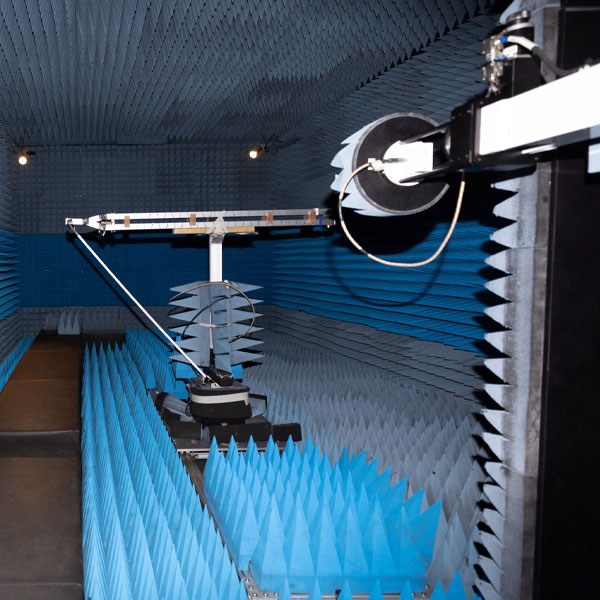
Located in Zacatenco, the facility is one of only two accredited labs in the country for precision antenna measurement.
FACTS OF INTEREST
The quietest facility at the Instituto Politécnico Nacional (IPN) is covered in polyurethane pyramids designed to absorb electromagnetic energy.
Today, it’s common to make phone calls, send text messages, browse social media, receive news updates, check emails, look up information, or stream movies and shows anytime, anywhere.
People take online classes, listen to personalized music, join video games with neighbors or players across the world, pay bills, ask virtual assistants for directions, and receive lab results digitally.
These everyday activities are possible thanks to telecommunications, which have become the backbone of modern communication—enabling human interaction, access to information, and the development of new technologies and applications.
However, long-distance electronic communication—without physical connections between transmitter and receiver—would not be possible without antennas, emphasized Dr. Jorge Roberto Sosa Pedroza, head of the National Telecommunications and Antennas Laboratory (LaNTA) at the IPN.
A specialist in communications and electronics at the Escuela Superior de Ingeniería Mecánica y Eléctrica (ESIME), Zacatenco campus, Dr. Sosa explained that antennas are devices that capture electromagnetic waves and convert them into electrical signals. These signals can then be transformed into images, audio, or data by televisions, radios, computers, or cell phones.
L Antennas are essentially electrical conductors, usually made from metals such as gold, silver, aluminum, or copper—with aluminum being the most common due to its cost efficiency. But their performance depends more on their design than their material.
“The first antenna ever built was a loop, used by Heinrich Hertz to validate James Clerk Maxwell’s electromagnetic wave theory. Later came the dipole antenna—two conductors powered by a transmission line. Today, there are many types, each defined by its radiation characteristics and geometry,” he explained.
Dr. Sosa noted that many functional antennas are developed through undergraduate, master’s, and doctoral theses under his guidance. These antennas are first modeled and tested using software and then physically evaluated in the IPN’s quietest facility and LaNTA’s most critical tool: the anechoic chamber.
A PhD in Communications and Electronics from IPN, Dr. Sosa explained that all antennas—whether developed for academic or commercial purposes—must undergo meticulous testing in an anechoic chamber. This sealed room is insulated from external interference and entirely lined with polyurethane pyramids coated in carbon and other materials that absorb electromagnetic energy.
“The chamber includes a 360° rotating table to hold antennas and a network analyzer attached to a vertical arm. This setup gathers 20 to 40 data points from the antenna, processed in real-time to visualize the electric field and radiation direction,” he said.
Measurements are taken in complete isolation to ensure a clean signal. The lab can test antennas ranging from 750 MHz, used in public safety and mobile networks, up to 18 GHz, used in wireless devices, broadband speakers, and some 5G technologies.
Dr. Sosa explained that there are two types of rooms in this category: electromagnetic compatibility chambers, which are only partially covered in absorbent material and used to detect signal interference (e.g., from motors to TVs or computers); and anechoic chambers, like the one at LaNTA, which evaluate antenna function and generate precise radiation diagrams.
Key Fact: The IPN’s LaNTA is one of only two accredited labs in Mexico capable of measuring antennas with high precision. The other is located at the National Metrology Center in Querétaro.
As a result, LaNTA has gained international recognition, receiving antennas from public and private institutions across Mexico, as well as from companies in Germany, Spain, France, China, the United States, and Canada, all seeking to validate their designs.
LaNTA is a multidisciplinary lab focused on teaching, collaboration, research, and innovation at the undergraduate and graduate levels. Its mission includes training highly specialized professionals and developing advanced antenna and communications systems.
With experience in the design of antennas for Satellites Solidaridad 1 and 2—built by Hughes Aircraft in Los Angeles in the 1990s—Dr. Sosa also led the design and construction of the antenna for the Painani 2 nanosatellite and performed the characterization of its ground station.
“When a British company raised a dispute before the International Telecommunication Union (ITU) in 2015, claiming that Mexico’s Morelos 3 satellite would interfere with theirs, LaNTA’s data proved the likelihood was extremely low,” he recalled.
The lab also contributed to Mexico City’s urban surveillance system, in collaboration with the UPIITA and the C5 emergency coordination center.
LaNTA has played a key role in designing the telecommunications system for the Interoceanic Corridor of the Isthmus of Tehuantepec, and the Sonora state backbone network, now providing connectivity to communities with as few as 50 inhabitants, including remote villages in the Sierra Madre Occidental.
The lab is currently working on an electromagnetic power distributor for antennas—a slotted waveguide array designed to generate a distributed magnetic field that focuses radiation in a specific direction. This innovative prototype is undergoing patent registration.